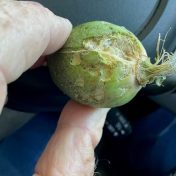There have been reports of mice activity in some crops around the Central Highlands, including grain sorghum, mungbean and cotton. Numbers of house mice (Mus domesticus) are generally low in cropping areas, but plagues can occur when conditions are favourable. Mouse populations have the potential to build rapidly and can do considerable damage in high numbers. Controlling plagues is both… Read more »
Wireworm adults and larvae are relatively common soil pests, attacking all field crops. Adults feed on germinating shoots, and larvae feed on germinating seed, seedling roots and shoots causing poor plant vigour or death. Wireworms are most common in zero till, areas with high stubble, or weedy fallows. These are habitats and food sources that sustain the beetles and enable… Read more »
Where there is a history of soil insect damage resulting in poor crop establishment a pre-sowing inspection of the affected fields is warranted to determine the likely risk to the upcoming summer crop. Grain baits are an effective way of monitoring for soil-dwelling insect pests of summer crops, and is preferable to sampling with a shovel, which is both time… Read more »
Crops are most susceptible to pest damage at the seedling stage. Pests feeding on seedlings can reduce plant establishment, increase weed competition, delay flowering and lower yields. In some cases there may be a need for re-sowing. Most of the establishment pests found in the northern region are soil-dwelling insects. Soil insects may be difficult to detect prior to sowing…. Read more »
The white-fringed weevil (Naupactus leucoloma) originates from South America and was first reported in NSW in 1932. Although generally associated with warm moist conditions, this pest is now found in many cropping areas throughout Australia and they appear to be increasing their range. Infestations often go unnoticed until crops are planted and once they are established they are difficult to… Read more »
Following the recent detection of symphyla in some cotton fields on the Darling Downs, DAFF Entomology have been testing sampling strategies for this potential pest of cotton. Literature for a similar symphyla species in North America suggested that baiting with potatoes may be an effective strategy for assessing symphyla abundance and whether individuals were actively feeding or in a restive… Read more »
An investigation into poor establishment in a field of cotton west of Dalby this week confirmed the presence of the soil dwelling symphyla as the likely cause. Symphylans are relatively common in most soils where they generally feed on decomposing organic matter. Symphyla as crop pests Symphyla have caused problems with crop establishment for a number of seasons in the… Read more »
This winter we’ve seen several instances of severe scarab damage to winter cereals (wheat, barley and oats) , including on crops at Jandowae and Felton on the Darling Downs. The photograph below shows that severe damage is mostly confined to areas of paddocks which were previously pasture – and this is where the highest scarab populations were found.
Field crickets High numbers of field crickets have been reported across the Darling Downs in the last couple of weeks, with some large aggregations of adults attracted to lights at night. Are these crickets doing damage to crops? The answer may well be yes. .


